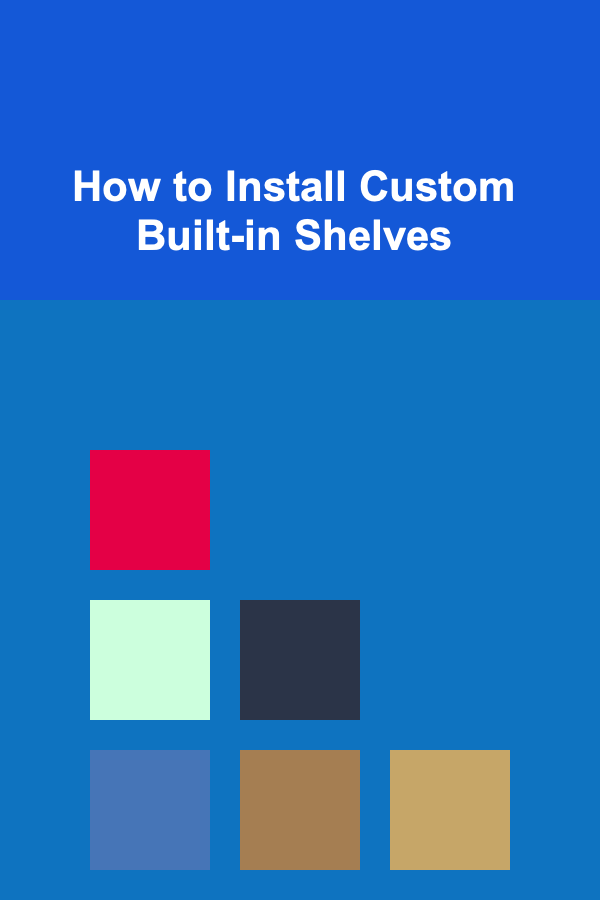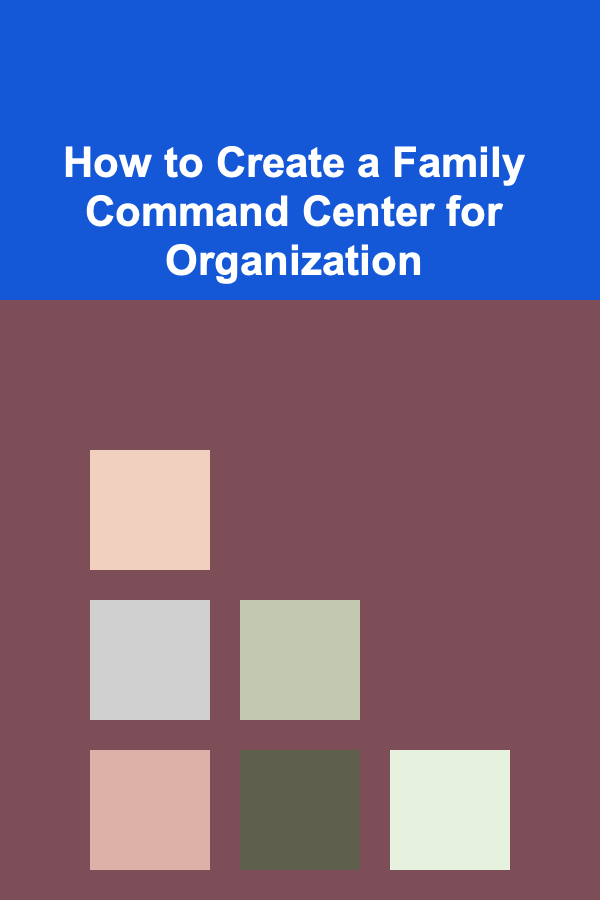
How to Install Custom Built-in Shelves
ebook include PDF & Audio bundle (Micro Guide)
$12.99$5.99
Limited Time Offer! Order within the next:

Installing custom built-in shelves is a rewarding and practical way to add storage and enhance the aesthetic appeal of your home. Whether you're looking to create a sleek, minimalist design or a more intricate, rustic shelving system, custom shelves can be tailored to fit any space, style, and functional need. This article will walk you through the entire process of installing custom built-in shelves, from planning and preparation to installation and finishing touches.
Why Choose Custom Built-in Shelves?
Custom built-in shelves are an excellent choice for maximizing space, particularly in rooms with unique layouts or limited storage options. Here are a few reasons why you might opt for custom shelves:
- Space Efficiency: Built-ins are designed to fit your space precisely, making them an excellent option for small rooms or odd-shaped walls.
- Aesthetic Appeal: Custom shelves offer the opportunity to create a design that perfectly matches your style, whether it's modern, traditional, or something in between.
- Increased Storage: Built-in shelves can be designed to accommodate books, décor, or even hidden storage compartments, making them highly versatile.
- Value Addition: Well-designed built-in shelves can increase the value of your home by enhancing both the function and appearance of your space.
Now that we understand the benefits, let's dive into the steps involved in installing custom built-in shelves.
Step 1: Plan Your Shelf Design
1.1. Assess Your Space
Before you start building, carefully measure the area where the shelves will be installed. Consider the height, width, and depth of the space to ensure your shelves will fit perfectly. It's also essential to evaluate the purpose of the shelves. Will they hold books, display décor, or house kitchenware? This will influence the materials you use, the number of shelves you need, and the overall design.
1.2. Choose Your Materials
The materials you select will determine the overall look, durability, and cost of the shelves. Common materials for custom built-in shelves include:
- Wood: A classic and versatile choice, wood offers a variety of finishes, from rustic to modern. Plywood, MDF (Medium Density Fiberboard), and hardwood are popular options.
- Metal: If you prefer a more industrial or minimalist design, metal shelves can be sleek and durable.
- Glass: Glass shelves can add a light, airy feel to a room. They're ideal for showcasing decorative objects.
- Stone or Marble: For a luxury look, stone or marble can make for sophisticated, long-lasting shelving.
1.3. Design the Shelving System
Consider the style you want for your shelves. Do you want a floating shelf design, where the brackets are hidden, or would you prefer more traditional, bracketed shelves? Some popular designs include:
- Floating Shelves: These shelves seem to "float" on the wall, supported by hidden brackets. They offer a clean, contemporary look.
- Bracket Shelves: Bracketed shelves are classic and offer more design flexibility. They can be made of wood or metal, and the brackets can be ornate or simple.
- Cabinet Shelves: For a more enclosed look, cabinet-style shelves can have doors, drawers, or cubbies, making them excellent for hiding clutter.
- Built-in Bookcases: These are shelves that fill an entire wall or alcove and can be built with trim and molding for a more architectural effect.
Sketch out your design to visualize how it will fit into the space. Pay attention to factors such as shelf height, spacing between shelves, and whether you want to incorporate additional elements like lighting or crown molding.
Step 2: Gather Tools and Materials
Once your design is finalized, it's time to gather everything you need for the installation. Here's a list of tools and materials you'll likely need:
Tools:
- Tape Measure: For accurate measurements.
- Level: To ensure your shelves are straight and aligned.
- Stud Finder: To locate the studs in the wall for secure mounting.
- Saw: A circular or jigsaw will work for cutting wood or MDF boards.
- Drill: For drilling holes in the wall and for screw placement.
- Screws and Wall Anchors: To securely attach the shelves to the wall.
- Screwdriver: To drive screws into place.
- Wood Glue: For securing parts of the shelving system together.
- Sandpaper or Sander: For smoothing rough edges on the wood.
- Paint or Stain: To finish your shelves after installation.
Materials:
- Wood (or other material): As discussed, choose the right type for your shelves.
- Brackets or Shelf Supports: If using brackets for support, select the right type and style.
- Trim or Molding: For a polished, finished look.
- Paint/Primer: Depending on your material, a coat of primer might be needed before applying the final paint or stain.
Step 3: Prepare Your Wall
3.1. Locate the Studs
Using your stud finder, locate the studs in the wall where you plan to attach the shelves. Studs are the vertical beams in your wall that will provide the necessary support for the shelves. Mark the location of the studs with a pencil, and make sure your shelves align with these marks to ensure they are securely mounted.
3.2. Measure and Mark
Measure the space where you want the shelves to go. Mark the desired height for the shelves on the wall, ensuring they are level. If you're building a series of shelves, mark the positions of each shelf, keeping consistent spacing between each one.
Step 4: Build and Cut the Shelves
4.1. Cutting the Shelves
Using your measurements and the saw, cut the wood or MDF panels to the correct size for each shelf. If your design includes a cabinet or compartment, cut those pieces as well.
4.2. Sand the Edges
After cutting, smooth out any rough edges with sandpaper or a sander. This will ensure the shelves have a polished, clean look.
4.3. Pre-Drill Holes for Screws
Before you install the shelves, pre-drill holes for the screws or brackets that will hold the shelves in place. This will make it easier to screw them into the wall without splitting the wood.
Step 5: Install the Shelving Brackets
5.1. Install Brackets (If Applicable)
If your shelves are bracketed, now is the time to install the brackets on the wall. Using the marks you made earlier, drill screws into the studs to secure the brackets. Make sure each bracket is level before tightening the screws.
5.2. Install Floating Shelves (If Applicable)
If you're installing floating shelves, you'll need to install hidden brackets or cleats in the wall. These will provide support without being visible. Attach the cleats or hidden brackets to the wall using screws, ensuring that they are level and securely attached to the studs.
Step 6: Mount the Shelves
Once the brackets are securely in place, it's time to install the shelves. If you're using floating shelves, gently slide each shelf onto its corresponding bracket or cleat, ensuring that the shelf sits securely and level. For bracketed shelves, simply place each shelf on its bracket and secure it with screws.
Step 7: Add Finishing Touches
7.1. Trim and Molding
To give your built-in shelves a polished, custom look, consider adding trim or molding along the edges. Use a saw to cut the trim to size, and attach it with wood glue or finishing nails.
7.2. Paint or Stain
Finally, finish your shelves by painting or staining them to match your décor. If you're using wood, apply a coat of primer before painting or staining. For a more modern look, you can even opt for a matte or glossy finish to give your shelves a sleek, refined appearance.
Step 8: Organize and Decorate
Once your shelves are installed and finished, it's time to organize and decorate them. Consider the function of each shelf---whether it's for books, plants, artwork, or storage---and arrange your items accordingly. Use decorative items that complement your room's color scheme and style, and don't be afraid to mix in some personal touches.
Conclusion
Installing custom built-in shelves is a rewarding DIY project that adds both style and function to any room. With careful planning, the right tools, and a little patience, you can create a beautiful, custom storage solution tailored to your needs. Whether you're looking to enhance your living room, home office, or kitchen, these shelves can help transform your space into something special. Enjoy the process, and most importantly, enjoy your new, organized space!
Reading More From Our Other Websites
- [Home Maintenance 101] How to Set Up a Functional Home Office: Tips for Organization and Productivity
- [Home Security 101] How to Choose the Right Home Security System for Your Needs
- [Organization Tip 101] Top Wood Rot Repair Products for Homeowners
- [Home Security 101] How to Improve Your Home's Security Without Installing Expensive Systems
- [Paragliding Tip 101] Top % Wind Tunnel Drills to Accelerate Your Paragliding Progress
- [Home Staging 101] How to Stage Your Home for a Successful Sale in a Competitive Market
- [Paragliding Tip 101] From Takeoff to Landing: A Lifecycle Analysis of Paragliding Equipment and Materials
- [Home Rental Property 101] How to Create an Inviting Outdoor Space for Renters
- [Stamp Making Tip 101] Crafting Perfect Impressions: A Beginner's Guide to Wood Block Stamp Making
- [Personal Care Tips 101] How to Use Sunscreen in Winter Months

How to Create a Family Command Center for Organization
Read More
How to Digitize Paper Documents for Better Organization
Read More
How to Make Smart Purchases During Sales
Read More
How to Market Your Bicycle Delivery Service to Local Businesses
Read More
Planning Your Encore: How to Plan for a Second Career in Retirement
Read More
10 Tips for Communicating Effectively with Hearing Loss
Read MoreOther Products

How to Create a Family Command Center for Organization
Read More
How to Digitize Paper Documents for Better Organization
Read More
How to Make Smart Purchases During Sales
Read More
How to Market Your Bicycle Delivery Service to Local Businesses
Read More
Planning Your Encore: How to Plan for a Second Career in Retirement
Read More